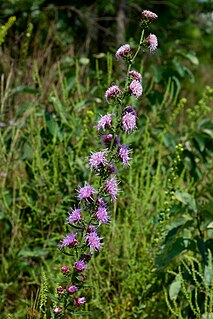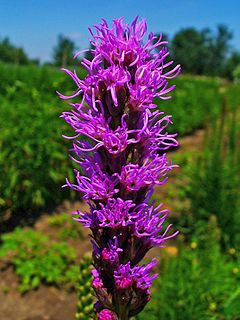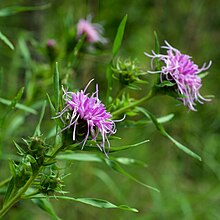
Liatris is a genus of flowering plants in the boneset tribe within the sunflower family native to North America. Its most common name is blazing star. Some species are used as ornamental plants, sometimes in flower bouquets.

Liatris aspera is a wildflower that is found in the mid to eastern United States in habitats that range from mesic to dry prairie and dry savanna.

Liatris pycnostachya, the prairie blazing star or cattail blazing star, is a perennial plant native to the tallgrass prairies of the central United States.

Echinacea simulata, commonly called pale purple coneflower or wavy leaf purple coneflower, is a species of flowering plant in the sunflower family. It is native to the east-central states of the United States, including Arkansas, Georgia, Illinois, Kansas, Missouri and Tennessee. The U.S. Department of Agriculture also reports it as native to North Carolina and Virginia. Wavy leaf purple coneflower has a relatively small distribution, and its locations are still being determined. Its natural habitat is dry, calcareous, open areas such as barrens and woodlands.

Liatris spicata, the dense blazing star or prairie gay feather, is an herbaceous perennial flowering plant in the sunflower and daisy family Asteraceae. It is native to eastern North America where it grows in moist prairies and sedge meadows.

Hymenoxys lemmonii is a species of flowering plant in the daisy family known by the common names Lemmon's rubberweed, Lemmon's bitterweed, and alkali hymenoxys. It is native to the western United States in and around the Great Basin in Utah, Nevada, northern California, and southeastern Oregon.
Liatris acidota, also known as the Gulf Coast gayfeather, sharp blazing star and sharp gayfeather, is a plant species in the aster family Asteraceae and genus Liatris. It is native to Louisiana and Texas in the United States, where it is found in habitats that include coastal prairies, dry prairie and savanna, where it is found in sandy to clay soils.

Liatris aestivalis, also known as the summer gayfeather, is a plant species in the aster family Asteraceae and genus Liatris. The specific epithet, aestivalis, is derived from Latin and means "pertaining to the summer". It is native to Oklahoma and Texas in the United States, where it is found in habitats that range from limestone outcrops to slopes and bases of slopes with shallow soils.
Liatris bracteata, commonly known as the bracted blazing star, or South Texas gayfeather, is a species of flowering plant in the aster family, Asteraceae. It is native to Texas in the United States, where it is found in coastal prairies, roadsides, and along railroads with clay or sandy loam soils. This species is of conservation concern in its native range.

Liatris chapmanii, also known as Chapman's blazing star or Chapman's gayfeather, is a plant species in the aster family Asteraceae and genus Liatris. It is native to Alabama, Florida and Georgia in the United States, where it is found in habitats such as dunes, beach strands, sand ridges, fields and roadsides, it also grows in longleaf pine savannas and other scrub habitats.
Liatris cokeri, also known as Coker's gayfeather and sandhills blazing star, is a plant species in the aster family Asteraceae and genus Liatris. It is native to North and South Carolina in the United States, where it is found in habitats such as sand ridges and sandy fields to roadsides; it is also found in turkey-oak and longleaf pine-oak plant communities. It blooms in late summer with purple flower heads.

Liatris cylindracea is a plant species in the aster family. It is native to eastern North America, where its populations are concentrated in the Midwestern United States. It is found in habitats such as prairies, limestone and sandstone outcroppings, bluffs, barrens, glades, woodlands and dunes.
Liatris cymosa, also known as Aggie-land gayfeather or branched blazing star, is a plant species in the aster family Asteraceae and genus Liatris. It is native to east central Texas in North America, where it is found in habitats such as post oak woodlands, fields, fence rows, woodland openings and edges, in clay soils. It blooms in mid to late summer with purple flower heads. It is of conservation concern.

Liatris elegans, known commonly as pinkscale gayfeather, pinkscale blazingstar, and elegant blazingstar, is a species of flowering plant in the aster family, Asteraceae. It is native to the southeastern United States as far west as Texas and Oklahoma.

Solidago nemoralis is a species of flowering plant in the aster family, Asteraceae. It is native to North America, where it is widely found in Canada and the United States. Its common names include gray goldenrod, gray-stem goldenrod, old-field goldenrod, field goldenrod, prairie goldenrod, dwarf goldenrod, and dyersweed goldenrod.

Liatris helleri is a species of flowering plants in the aster family known by the common names Heller's blazing star and Heller's gayfeather. It is native to the Appalachian Mountains of the southeastern United States, found in the states of North Carolina, Virginia, West Virginia, and Maryland. It is threatened by recreational activities in its habitat, and is federally listed as a threatened species.

Liatris provincialis is a species of flowering plant in the aster family known by the common names Godfrey's blazing star and Godfrey's gayflower. It is endemic to Florida in the United States, where it is limited to Wakulla and Franklin Counties in the Panhandle.

Cardamine douglassii, the limestone bittercress or purple cress, is a perennial forb native to the eastern and central United States as well as the province of Ontario in Canada, that produces white to pink or purple flowers in early spring.

Liatris squarrosa, commonly called the scaly blazingstar, is an herbaceous perennial plant native to eastern and central North America, with most populations in the Southeastern United States. It is a somewhat conservative species, often found in dry or rocky areas of native prairie and savanna vegetation. It produces purple flowerheads in the summer.

Liatris hirsuta, commonly called hairy gayfeather, is a species of flowering plant in the aster family (Asteraceae). It is native to North America, where it is found primarily in the Midwestern and South-Central regions of the United States. Its typical natural habitat is glades, rocky bluffs, and upland prairies.
















